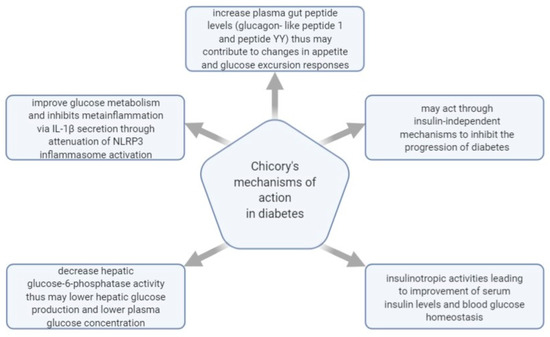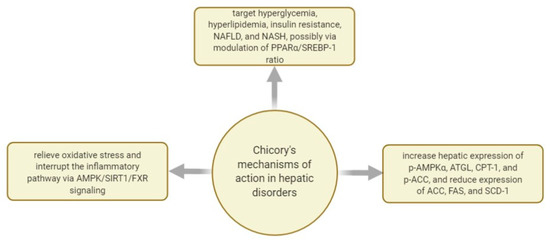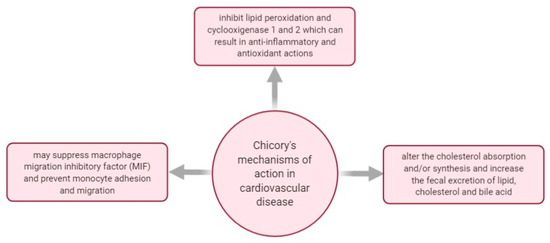Cichorium intybus L., commonly named chicory, is a perennial herbal plant of the dandelion family Asteraceae, mainly seen with bright blue flowers, and seldom pink or white. Generally distributed in Asia and Europe, all the plants’ parts were traditionally used in medicinal preparations due to their considerable contents of antioxidant phytochemicals thought to have a beneficial impact in preventing and treating various illnesses such as fever, diarrhea, jaundice, and gallstones. Different chicory types are grown for their salad leaves, chicons, or roots, and regularly used for inulin extraction, for preparing coffee substitutes, or for feeding livestock.
This entry is based on a literature review and highlights the beneficial and therapeutic action of chicory extracts and their confirmed or hypothesized mechanism of action in diabetes, hepatic disorders, and cardiovascular disease, as indicated by the results of in vivo and in vitro studies, on cell lines, human and animal models.
- diabetes
- hepatic disorders
- cardiovascular disease
- chicory
- cichorium intybus
1. Chicory Extracts and Their Natural Products Studied for Therapeutic Potential in Diabetes
After checking the literature published before 2010, it resulted that there are no relevant studies regarding C. intybus roots extracts and their potential benefits in managing diabetes. However, it was indicated that the whole chicory plant extract possesses hypoglycemic and hypolipidemic properties.
Table 1 summarizes some of the later studies conducted to assess the chicory’s action in managing diabetes.
Table 1. Chicory extracts in diabetes and their potentially responsible effective compounds.
| Extract Type and Plant Part | Type of Study | Results | Responsible Functional Natural Products | References |
|---|---|---|---|---|
| Chicory seeds powder decoction | in vivo, in T2D patients (19 men and 11 women) | - decrease fasting and postprandial blood glucose | - caffeic acid, chlorogenic acid, chicoric acid | [1] |
| Chicory root fructans | in vivo, in normal, and obese diabetic and non-diabetic murine models | - modulate body weight, hyperglycemia, and hypercholesterolemia | - inulin-type fructans | [2] |
| Chicory seeds aqueous extract | in vivo, in murine diabetes models | - inhibit the progression of diabetes | - unspecified antioxidant compounds | [3] |
| Chicory leaves hydroethanolic extract | in vivo, in nicotinamide-STZ–induced diabetes in mice | - anti-hyperglycemic action, improve serum insulin levels | - lactucin | [4] |
| Chicory leaves methanolic extract | in vivo, in high-fat-diet-induced diabetes in mice | - enhance glucose metabolism and impede meta-inflammation | - sesquiterpene lactones (lactucin) | [5] |
Inulin-type fructans extracted from chicory, Jerusalem artichoke, and blue agave have been tested in diabetic and non-diabetic models for their effect on body weight, blood metabolites, and fecal bacteria. The results demonstrated that fructans could modulate body weight, hyperglycemia, and hypercholesterolemia in obese and diabetic subjects. Thus, dietary fructans have beneficial health effects in inhibiting risk factors linked to liver steatosis in diabetic patients [2].
The effect of chicory seeds was also studied in glucose tolerance and the metabolic profile in diabetic rats. Late and early stages of T2D were induced in murine models using STZ and a mix of STZ and niacinamide. The aqueous extract of chicory seeds was administered 28 days through injections of 125 mg/kg body weight. The study’s results indicated that chicory had a noticeable impact on inhibiting the progression of T2D and in hindering the evolution of associated complications [3].
The effect of C. intybus leaves over hyperglycemia was also studied together with other plants of Egyptian origin in nicotinamide-streptozotocin–induced diabetic mice. The hydroethanolic extract of Cichorium intybus L., as in the case of Cassia acutifolia, Salix aegyptica, and Eucalyptus globulus extracts, indicated the greatest anti-hyperglycemic action compared to the other examined plants, which is an action that was associated with a potential improvement of serum insulin levels [4].
Chicory seeds were evaluated regarding their influence over postprandial blood glucose, fasting blood glucose, and glycosylated/glycated hemoglobin in T2D patients (19 men and 11 women) with poor glycaemic control. The results showed that chicory seed effectively decreases fasting and postprandial blood glucose of T2D patients. The results also suggested that partially purified preparations of chicory seeds (seed powder decoction) are more valuable than crude chicory seed powder [1].
Chicory leaves were also studied for their properties in preventing diet-related T2D. In 2016, a methanolic extract was proven to inhibit interleukin secretion through the mitigation of NLRP3 inflammasome activation in T2D induced in mice through highly lipidic diets. The anti-diabetic effect was expressed by enhancing glucose metabolism and impeding meta-inflammation, which is a result triggered most likely by the plant’s content of sesquiterpene lactones such as lactucin [5].
Figure 1 shows some of the mechanisms of actions investigated regarding C. intybus’s effect in managing diabetes.

Figure 1. Mechanisms of action regarding chicory’s effect in managing diabetes.
2. Chicory Extracts and Their Natural Products Studied for Therapeutic Potential in Hepatic Disorders
Although there are quite a few indications about chicory being beneficial in diabetes, there are some studies conducted over the last 10 years on chicory’s potential of managing hepatic diseases. In Table 2, there are some summaries of the studies conducted to assess the chicory’s action in managing hepatic disorders.
Table 2. Chicory extracts in hepatic disorders and their potentially responsible effective compounds.
| Extract Type and Plant Part | Type of Study | Results | Responsible Functional Natural Products | References |
|---|---|---|---|---|
| Dried chicory root | in vivo, in growing swine models | - hepatoprotective action, potential therapeutic action in metabolic disorders | - inulin | [6] |
| Chicory seeds aqueous extract | in vivo, in diabetes, and oleic acid-induced NAFLD and NASH | - alleviate hyperglycemia, reduce lipidemic content, modulate insulin resistance, alleviate NAFLD and NASH | - caffeic acid, chlorogenic acid, and chicoric acid | [7] |
| Chicory root fractions | in vivo, in high-fat-induced NAFLD murine models | - alleviate NAFLD via AMP-activated protein kinase | - polysaccharides (sorbin, glucose, fructose, and glucitol) | [8] |
| Whole chicory plant powder extract | in vivo, in thioacetamide-induced liver cirrhosis in murine models | - reduce oxidative stress, hepatoprotective action | phenolics, chicoric acid, inulin | [9] |
Chicory seeds were studied for their effect on diabetes and oleic acid-induced NAFLD and NASH. The aqueous extract of chicory seeds (containing caffeic acid, chlorogenic acid, and chicoric acid) was able to simultaneously target hyperglycemia, hyperlipidemia, insulin resistance, NAFLD, and NASH, possibly via modulation of peroxisome proliferator-activated receptor-alpha and sterol regulatory element-binding protein-1c ratio [7].
To further investigate its hepatoprotective actions, C. intybus was studied for its ability to modulate the expression of liver cytoskeletal proteins in growing pigs. It was shown that the dried chicory root and chicory inulin acts as hepatoprotective due to their ability to regulate hepatic protein expression responsible for energetic metabolism. Moreover, having an impact on lipid-lowering mechanisms, chicory’s compounds like inulin can help manage other metabolic disorders like cardiovascular disease and diabetes. However, it was suggested that further clinical studies are needed to validate this potential [6].
Isolated polysaccharides from chicory root, predominantly comprised of sorbin, glucose, fructose, and glucitol, were studied in high-fat diet-induced NAFLD. After histopathological examination of rat livers, it was concluded that chicory polysaccharides might be efficient in managing non-alcoholic fatty liver disease via AMP-activated protein kinase [8].
The whole plant was studied as well for its action in thioacetamide-induced liver cirrhosis. Diet-supplementation of chicory powder has shown that it can protect against thioacetamide-induced liver damage, fibrosis, and cirrhosis by reducing oxidative stress and disrupting the inflammatory pathway via AMPK/SIRT1/FXR signaling [9].
In Figure 2, there are some mechanisms of action investigated regarding C. intybus’s effect in managing hepatic disorders.

Figure 2. Mechanisms of action regarding chicory’s effect in managing hepatic disorders.
3. Chicory Extracts and Their Natural Products Evaluated for Potential Therapeutic Potential in Cardiovascular Disease
As seen in Table 3, after checking the literature published before 2010, it was found that there are only a couple of relevant studies regarding C. intybus root extracts and their potential benefits in managing cardiovascular diseases. However, in Table 9, there are some summaries of the studies conducted to assess the chicory’s action in managing cardiovascular disease.
Table 3. Chicory extracts in cardiovascular diseases and their potentially responsible effective compounds.
| Extract Type and Plant Part | Type of Study | Results | Responsible Functional Natural Products | References |
|---|---|---|---|---|
| Chicory root coffee | in vivo, in 27 healthy human volunteers | - anti-thrombotic and anti-inflammatory action | - phenolics, caffeic acid | [10] |
| Whole chicory water extract | in vivo, hyperuricemia induced in quail models | - reduce risk factors of CVD by lowering serum uric acid, reinstate gut microbiota diversity | NA | [11] |
| Whole chicory plant | in vivo, in hyperlipidemic murine models | - hypolipidemic, anti-lipotoxic, antioxidant, and anti-atherogenic action | - inulin, unsaturated sterols, flavonoids, polyphenol, and tannins | [12] |
| Chicory roots water-soluble extract | in vivo, on male Sprague-Dawley rats and their lipid metabolism | - lead to higher serum high-density lipoprotein cholesterol and generally lower low-density lipoprotein cholesterol concentrations | - inulin | [13] |
| Chicory leaves water extract | in vitro, lipid peroxidation (LPO) and cyclooxygenase (COX-1 and COX-2) enzyme inhibitory activities | - inhibited LPO and COX- 1 and COX-2, which can result in anti-inflammatory and antioxidant actions | - anthocyanins (cyanidin-3-O-glucoside) | [14] |
Over the last 10 years, only a few studies indicated the chicory’s therapeutic value in managing cardiovascular diseases. For example, in 2011, a group of researchers investigated the thrombosis preventive potential of chicory coffee consumption. To study the potential cardiovascular benefits, 27 healthy volunteers drank 300 mL of coffee in the morning, made from 20 g of ground chicory coffee, for 7 days. As a result, blood and plasma viscosity were substantially diminished. Major improvements were noticed in red blood cell deformability with an overall antithrombotic and anti-inflammatory action, which might be attributed to the chicory coffee’s phenolics, including caffeic acid [10].
In another instance, the whole chicory plant was administered as a diet supplement to Triton WR-1339-induced hyperlipidemia in doses of 10 g/100 g diet for 4 weeks, and it was concluded that chicory acts as a hypolipidemic, anti-lipotoxic, antioxidant, and anti-atherogenic factor. Moreover, it was suggested that, due to its power to regulate cholesterol biosynthesis, lipogenic enzyme ACC, vascular inflammation, and redox status, C. intybus could protect against cardiovascular and hepatic steatosis [12].
It has been proven that an elevated level of uric acid is an independent risk factor for metabolic syndrome, cardiovascular disease, and kidney disease. In this sense, a recent study was published investigating chicory extracts’ power to ameliorate hyperuricemia in quail. Quails suffering from hyperuricemia induced by high-purine diets were fed with chicory extract at various doses. It was found that the chicory water extract reinstated gut microbiota diversity in quail models of hyperuricemia and presented anti-hyperuricemia action, indicating that non-starch polysaccharides can enhance microbial diversity. Moreover, high (16.7 g/kg chicory inulin water solution) and middle doses (6.6 g/kg chicory inulin water solution) of chicory demonstrated a steady action of lowering serum uric acid in purine-induced hyperuricemia quails. Given this, it is suggested that chicory extracts can help reduce risk factors of CVD [11].
In Figure 3, there are some mechanisms of action investigated regarding C. intybus’s effect in managing cardiovascular disease.

Figure 3. Mechanisms of action regarding chicory’s effect in managing cardiovascular disease.
4. Conclusion
According to the reviewed publications, it seems like chicory roots were the more intensively studied plant part of chicory regarding the activity of its natural products in diabetes, hepatic disease, and cardiovascular diseases. It was shown that chicory root extracts comprising inulin and inulin-type fructans are beneficial in the management of metabolic disorders such as CVD and diabetes. Chicory root polysaccharides can exert hepatoprotective and preventive actions in NASH, can control hyperglycemia, and present antithrombotic and anti-inflammatory action due to the chicory root’s phenolics like caffeic acid. A few studies conducted on chicory leaves extracts suggest that chicory leaves are efficient in managing diabetes due to their ability to improve glucose metabolism and the serum insulin level. On the other hand, chicory seeds also present therapeutic benefits in diet and drug-related hepatic ailments and diabetes.
References
- Katiyar, P.; Kumar, A.; Mishra, A.K.; Dixit, R.K.; Gupta, A.K.; Evaluating hypoglycemic potential of Kasni (Chicorium intybus) seed preparations in type 2 diabetes mellitus patients. IJPSR 2015, 6, 4534–4543, .
- Juan A. Rendón-Huerta; Bertha Juárez-Flores; Juan M. Pinos-Rodríguez; Juan Rogelio Aguirre-Rivera; Rosa E. Delgado-Portales; Effects of Different Sources of Fructans on Body Weight, Blood Metabolites and Fecal Bacteria in Normal and Obese non-diabetic and Diabetic Rats. Materiae Vegetabiles 2011, 67, 64-70, 10.1007/s11130-011-0266-9.
- Abdolreza Ghamarian; Mohammad Abdollahi; Xiaogang Su; Azita Amiri; Ali Ahadi; Azin Nowrouzi; Effect of chicory seed extract on glucose tolerance test (GTT) and metabolic profile in early and late stage diabetic rats. DARU Journal of Pharmaceutical Sciences 2012, 20, 56, 10.1186/2008-2231-20-56.
- Sameh Fekry Abouzid; Osama Mohamed Ahmed; Rasha Rashad Ahmed; Ayman Mahmoud; Ehab Abdella; Mohamed Badr Ashour; Antihyperglycemic Effect of Crude Extracts of Some Egyptian Plants and Algae. Journal of Medicinal Food 2014, 17, 400-406, 10.1089/jmf.2013.0068.
- Do-Wan Shim; Ji-Won Han; Young-Eun Ji; Woo-Young Shin; Sushruta Koppula; Myong-Ki Kim; Tae-Kweon Kim; Pyo-Jam Park; Tae-Bong Kang; Kwang-Ho Lee; et al. Cichorium intybus Linn. Extract Prevents Type 2 Diabetes Through Inhibition of NLRP3 Inflammasome Activation. Journal of Medicinal Food 2016, 19, 310-317, 10.1089/jmf.2015.3556.
- Lepczy ´nski, A.; Herosimczyk, A.; Ozgo, M.; Marynowska, M.; Pawlikowska, M.; Barszcz, M.; Taciak, M.; Skomiał, J.; Dietary chicory root and chicory inulin trigger changes in energetic metabolism, stress prevention and cytoskeletal proteins in the liver of growing pigs—A proteomic study. J. Anim. Physiol. Anim. Nutr. 2017, 101, e225–e236, .
- Nasrin Ziamajidi; Shahnaz Khaghani; Gholamreza Hassanzadeh; Safura Vardasbi; Shahram Ahmadian; Azin Nowrouzi; Seyed Mahmood Ghaffari; Afshin Abdirad; Amelioration by chicory seed extract of diabetes- and oleic acid-induced non-alcoholic fatty liver disease (NAFLD)/non-alcoholic steatohepatitis (NASH) via modulation of PPARα and SREBP-1. Food and Chemical Toxicology 2013, 58, 198-209, 10.1016/j.fct.2013.04.018.
- Yulong Wu; Feng Zhou; Haitao Jiang; Zhengjiong Wang; Chun Hua; Yuanshu Zhang; Chicory (Cichorium intybus L.) polysaccharides attenuate high-fat diet induced non-alcoholic fatty liver disease via AMPK activation. International Journal of Biological Macromolecules 2018, 118, 886-895, 10.1016/j.ijbiomac.2018.06.140.
- Keshk, W.A.; Soliman, N.A.; Ali, D.A.; Elseady, W.S.; Mechanistic evaluation of AMPK/SIRT1/FXR signaling axis, inflammation, and redox status in thioacetamide-induced liver cirrhosis: The role of Cichorium intybus linn (chicory)-supplemented diet. J. Food Biochem. 2019, 43, e12938, .
- Edit Schumacher; Éva Vigh; Valéria Molnár; Peter Kenyeres; Gergely Feher; Gábor Késmárky; Kalman Toth; János Garai; Thrombosis Preventive Potential of Chicory Coffee Consumption: A Clinical Study. Phytotherapy Research 2011, 25, 744-748, 10.1002/ptr.3481.
- Meng Bian; Juan Wang; Yu Wang; Anzheng Nie; Chunsheng Zhu; Zongxi Sun; Zheng Zhou; Bing Zhang; Chicory ameliorates hyperuricemia via modulating gut microbiota and alleviating LPS/TLR4 axis in quail. Biomedicine & Pharmacotherapy 2020, 131, 110719, 10.1016/j.biopha.2020.110719.
- Walaa A. Keshk; Saad A. Noeman; Impact of Chicory-Supplemented Diet on HMG-CoA Reductase, Acetyl-CoA Carboxylase, Visfatin and Anti-Oxidant Status in Triton WR-1339-Induced Hyperlipidemia. Journal of Food Biochemistry 2015, 39, 164-172, 10.1111/jfbc.12115.
- Meehye Kim; Hyun Kyung Shin; The Water-Soluble Extract of Chicory Influences Serum and Liver Lipid Concentrations, Cecal Short-Chain Fatty Acid Concentrations and Fecal Lipid Excretion in Rats. The Journal of Nutrition 1998, 128, 1731-1736, 10.1093/jn/128.10.1731.
- Vanisree Mulabagal; Haibo Wang; Mathieu Ngouajio; Muraleedharan G. Nair; Characterization and quantification of health beneficial anthocyanins in leaf chicory (Cichorium intybus) varieties. European Food Research and Technology 2009, 230, 47-53, 10.1007/s00217-009-1144-7.
